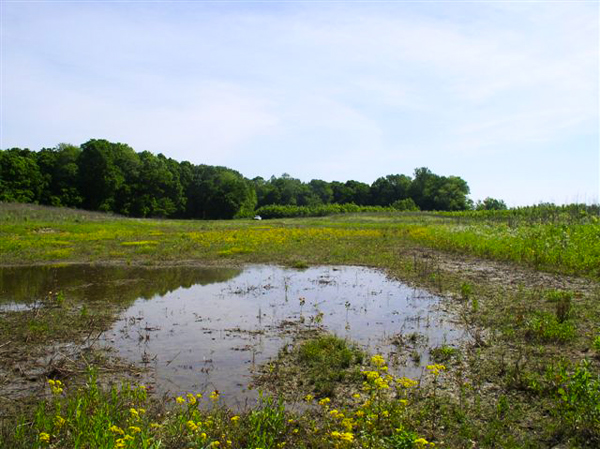
By Art lander Jr.
FRANKFORT, Ky. – Seasonally flooded impoundments, also referred to as moist soil units, can produce a smorgasbord of native plants that migrating waterfowl will feed on throughout the fall and winter hunting seasons.

“Natural foods are superior to row crops because they provide more complete nutrition, said Kevin Tucker, a private lands wildlife biologist with the Kentucky Department of Fish and Wildlife Resources. “With the proper water level manipulation its possible to encourage smartweed, wild millet, fall panicum and sedges, which will attract mallards and other species of dabbling ducks.
Seasonally flooded impoundments typically average about 10 acres in size, but can be as small as 1 1/2 acres or larger than 100 acres. The optimum water depth is about 18 inches.
The best locations for seasonal impoundments are low areas along rivers or in creek bottoms, where runoff water collects and the soil types hold water. Construction should take place during the dry part of the summer, but Tucker, who has worked in western Kentucky since 1995, said it can be too dry. “There has to be enough moisture to be able to compact the dirt levee, he said.
Water levels are controlled by whats called a stop log structure. This consists of a three-sided metal box with slots on the front facing the water where boards can be stacked on top of one another. “When water overtops the boards, it falls into the box and runs out a pipe through the levee, said Tucker. “Adding boards raises the water level in the impoundment, and removing boards lowers it.
After the growing season is over in early fall, the water level should be brought up slowly. “That way not all the food will be flooded at the same time, said Tucker. “You want the water level to peak in early- to mid-December.
With proper water level management, natural foods will be available to waterfowl for a much longer period of time than grains such as corn or millet, which deteriorate rapidly when flooded continuously.
Seasonally flooded impoundments continue to provide food long after the weed seed are gone in the late winter, when ducks migrate back through Kentucky on their way to their breeding grounds.
“Ducks forage through the fodder or plant debris, feeding on larval insects and other invertebrates that provide much-needed protein, Tucker said.
The draining of seasonal impoundments should not begin until early- to mid-April. “You want to slowly take the water level down, removing one board every two weeks, said Tucker. “By slowly lowering the water level you get a much different vegetative response. Drop the water level too fast and your mudflats will dry up. That will promote the growth of bad weeds such as the cocklebur.
Hunters with access to wetlands could have some excellent hunting this fall. Many of the ponds and sloughs in western Kentucky that dried up during the summer drought are now covered with lush stands of native grasses, providing excellent duck forage.
Duck numbers are up, too. The U.S. Fish and Wildlife Service (U.S.F.W.S.) reports the 2012 estimate of breeding ducks in the traditional survey area was 48.6 million birds, a 7 percent increase from last year’s record total. This is the largest estimate since annual waterfowl surveys began in 1955. Mallards were up 15 percentfrom 9.2 million birds in 2011 to 10.6 million this year. Only twice, in 1958 and1999, have more mallards been recorded during the May survey. Populations of all other major duck species, except northern pintails, were either above or statistically similar to 2011 estimates.
Seasonally flooded impoundments will help you take advantage of this fantastic waterfowl bounty this fall.
Author Art Lander Jr. has been writing about the outdoors since the 1970s. He is a staff writer for Kentucky Afield Magazine.


Be the first to comment